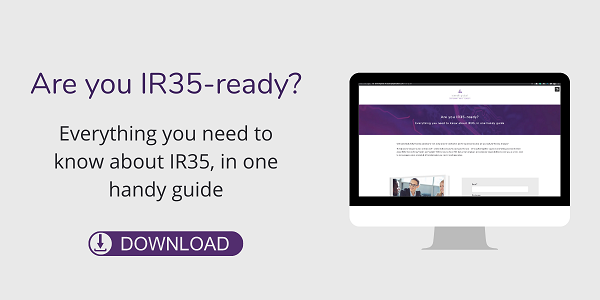It’s nearly time. In April 2021, the new IR35 rules come into force for the private sector – rules that are already in place for the public sector. Are you ready for these changes?
If your company works with contract staff, the new IR35 reform could well be a problem. You’ll need to establish whether the rules apply – both to existing and to future contractors – so that neither you nor your contractors are accused of tax avoidance. As the hiring company, you will be responsible for determining whether a contractor falls within IR35 rules.
Are you ready for IR35? Let us know if there’s anything we can do to help.
Here, we lay out what ‘inside IR35’ and ‘outside IR35’ actually mean, how to check a contractor’s IR35 status, and what you’ll need to do before April.
What does it mean to be ‘inside IR35’ or ‘outside IR35’?
Put simply, IR35 legislation applies if an individual you have hired as a contractor would actually be an employee ‘if there was no intermediary’. By ‘intermediary’, HMRC are referring to someone who is avoiding paying an employee’s income tax and National Insurance Contributions that they would be paying if hired directly. These tax benefits come through working through a personal service company (PSC) – working through a limited company instead of being added to PAYE.
Inside IR35 – ‘deemed employment’
Under the new intermediaries legislation, contractors who fall inside IR35 will be ‘deemed employees’ of the end client. As such, any tax efficiency from contracting will be lost, as they will be regarded as subject to PAYE.
“A ‘deemed payment’ will need to be made to HMRC.”
In cases where a contractor is inside IR35, a ‘deemed payment’ will need to be made to HMRC at the end of the tax year. Alternatively, the contractor will need to organise a contract review prior to the new rules coming in, to avoid IR35 applying.
Outside IR35
To be considered as operating outside of IR35 rules means that a contractor works as a genuine contracted business to a client in the private sector, rather than acting as an employee. However, even if a contractor has determined that they are outside of IR35, they can still be subject to checks from HMRC.
How to check if your contractors are inside IR35
While many recommend using the government’s CEST (Check Employment Status for Tax) tool, we would advise against it. This tool has proved to be incredibly basic – and, in some legal cases in the public sector, has been found by HMRC to have wrongly determined a contractor’s IR35 status.
For a detailed review of IR35 for employers, download our new guide.
Instead, a business should establish the following:
-
How much control the contractor has over the work they do, their hours and their workplace.
-
Whether the contractor is able to send a substitute to do the work, whether this has ever been done, and whether the hiring company can reject this substitute.
-
Whether there is a binding commitment or contract for the hiring company to offer work, or the contractor to supply work.
-
How integrated the contractor is into the business: whether they would describe themselves as working for the company, or working for themselves.
-
Whether the contractor has taken on any major financial risk – like buying their own equipment.
-
Various other factors, like how much of the contractor’s time the work takes up, and whether there are any restrictions on other work they can do.
What to do before April
There are four key things that all businesses who hire – or are planning to hire – contractors should do before April 2021 comes around.
1. A review of all members of staff – both contract and permanent
Conducting a review of all permanent and contract staff, to establish which members of your team fall inside and outside IR35. While the government has provided an online tool to do so, this is inefficient: instead, establish in-house expertise or hire a professional recruitment law firm to undertake this task for you.
2. Understand likely costs (both financial and administrative)
This will be particularly pertinent to small businesses, who may find that keeping on contractors with IR35 rules in place will be too costly. Do you need to replace contract staff with permanent staff, or hire an alternative contractor who is willing to work within IR35?
3. Communicate the changes to all involved
All changes should be communicated with both current and potential future contractors in a clear and transparent way. Not only does this give them time to prepare and to give their feedback – it also aids their understanding, cements trust and strengthens your relationship with them.
4. Review recruitment processes
Are your job adverts designed with IR35 in mind? Do they make it clear whether a contract role is inside or outside of IR35? It’s not just the job advert itself that will need changing, though – there should be a process in place so that each application and interview is accompanied by a frank discussion about the role’s IR35 status.
For more detail on what should be done before the new rules are enforced, read IR35 Checklist: What do employers need to do before April 2021?
It’s not long until the new IR35 rules are in place. Are you and your contractors prepared?
To find out more about what you need to do before April 2021, watch our recent webinar, What Do Employers Need To Do Before April 2021.
Images via Pixabay and Unsplash


